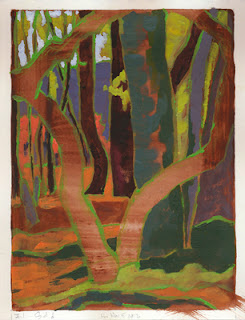Week 5 More on Practical teaching approaches
Weeks 5 Summary: More on Practical teaching approaches
University of London, UCL Institute of Education & Dyslexia International
This week, Dr Goetry demonstrated the multisensory teaching of reading in classrooms, assessing phonological awareness via genration, substitution, concatination [and five others which are...], helping students with comprehension an d compostiong. His students appeared to be first graders, and the class ran through a number of exercises. First, they touched letters while blindfolded, trying to sound out the word presented with them. In the next lesson, they used legos or checkers or other counters to count out syllables: three for “kangaroo”, etc. Or, they put a hand below their jaws, and counted out the number of times that their jaws hit the top of their hands for “go ril la”. Then they clapped out “a lli ga tor. Next, they were given a list of words on paper, took a pencil, and drew a horizontal line after each syllable. For any student who had difficulty, Dr Goetry put down his thumb to hide the rest of the word after each syllable.
In the following lesson, the children are given the 26 letters, which they arrange as an alphabetical rainbow. They put on blindfolds, and each child is given a letter from their arc. The children together need to put together their word. When they put away their letters, they are given special instructions: “put away every third letter.”
Dr Goetry demonstrated a puppet centric way of teaching onset and rime. His puppet's name was “Blap”, and he came with a story: “Blap comes from a planet far away, and he is very scared. Every word on that planet ends with the 'ap' rime, so let's see if we can help him feel more relaxed by giving him familiar words. What real or imaginary words end with /ap/?” When the children provided “sap, clap, nap, gap, map, tap, flap, fap, cap, tap,” Dr Goetry said Blap was feeling better, not trembling anymore.
Then, still with the hand puppet, and using the counters, Dr Goetry had the puppet try to speak English, and offered up the word “opet”. He asked how many counters, one for each sound, the kids counted – 4. Then the kids were advised to take away one of the counter/sounds to make a real English word. Blap added “flove”, and “fishay” to the list.
Next, moving on to substitution, Blap wanted the kids to correct “fex” (four sounds) and “gup” to be “fox” and “gap”.
Dr Goetry explained to the Coursera course followers the concept of “co-articulation”, emphasizing that the pauses between words are made in the mind of the listener trying to separate out the words, not in the mouth of the speaker.
Then he moved onto another puppet task, focused on concatenation. This time, the puppet, Ming, is very shy, and she says words bit by bit. The students are asked to put the words together. “Sis” “ter” – and the children say “sister”. The students do the same for “pi” “lot” and “con” “tact”. Then, moving on just to simple phonemes, Ming may say “mm” “oo” “n” for “moon”, or “s” “t” “ep”. Dr Goetry recommends that the teacher prerecords the prompts, preferably using someone else's voice, to allow for allophonic variation. If you manage to do this, you will say that this is Ming's voice, and that she was too shy to speak in person. During the Ming lesson, the students worked on segmentation, substitution, initialisms, and deletion.
The different methods of improving reading instruction that Dr Goetry demonstrated illustrated four modalities of multisensory teaching: auditory, visual, oral-kinaesthetic, and manual-kinaesthetic.
5.10
Reading or spelling should not happen unless the child has already been set up with multisensory grapheme to phoneme introductions. Phoneme-grapheme correspondences should all have been seen before with multisensory techniques. An important concern in reading, spelling, comprehension, and composition is to give children their own tools of self assessment and correction, rather than being the yourself the one to get out the red pen, saying, “No, this is wrong.” Instead of taking their work away, and then correcting it, there are alternatives. For example, with a spelling test, the teacher can give the correct spelling at the end, so the student can look at what she has done, then go back to compare and correct. “I can tell you that most dyslexic children are able to spot their mistakes, so this is a very powerful tool,” says Dr Goetry. It also prevents the student's being marked as a poor student. From my own experience, and that of my child's, I can say that fear of being the weakest link, stupider than others, figured large in our academics.
As Dr Goetry points out, reinforcing self-confidence can also improve internal, intrinsic motivation, while external correction in an already weak area only hinders the effectiveness of extrinsic motivation. Allowing the child to find and correct her own mistakes promotes autonomy.
An effective approach is in grouping words into families. Dyslexic children will often miss similarities, unless explicitly taught them. For example, in the I-G-H-T family are the members fight, right, flight, night, might, sight, knight, light, bright. The ideal approach is to use color coding for these families. The same approach can be used for onsets, such as “sp” of spell, spun, speech, spoke, and “ing” words such as spring, string, frowning.
Dr. Goetry recommends teaching children to cross out silent letters, and work with the remaining grapheme-phoneme correspondences. In the example “said”, there are still two regular phonemes: “s” and “d”.
5.11 Multisensory techniques for reading and spelling Dr Goetry
Cursive script is a discipline that goes in and out of favor for young children, but Dr Goetry emphasizes its usefulness for students with dyslexia. Every time the pencil is lifted from the paper, he says, is an opportunity for the brain to skip, or reorder, or lose track, while cursive writing is continuous. Dr Goetry demonstrates his way of teaching American D'Nealian cursive script, using four differently colored lines as guides for the words, with bottom being red for the center of the Earth, then brown for the soil, green for grass, and a blue line for sky above them all.
In the learning of new words, Dr Goetry proposes the following: teacher says the word, student repeats, student names the letters of the word, then names again the words as she writes the word in cursive. Then you show the word, and the pupil checks whether or not she is correct. This uses all four sensory modalities: oral- kinaesthetic, manual-kinaesthetic, auditory, and visual.
Any time we can, teachers are encouraged to record the student's voice for themselves, because this has been shown to be a powerful memorization tool. Other memorization methods include using acrostic mnemonics, such as Big Elephants Can Always Understand Small Elephants to remember how to spell “because”, or Silly Aiden Is Dancing for “said”. Or, in order to remember how many c's and s's in necessary: “It is necessary to have a shirt with one Collar and two Sleeves.”
5.12 and 5.13 Dr Jenny Thomson discussed Comprehension methods. She talked about prereading, using the KWL framework – the thing you Know, What you Want to know, and what have you Learned? 14 point font, and sans serif such as Arial and Open Dyslexic, increased letter spacing, and double lines can all help with easier reading. A way to test comprehension is to cut up chunks of text, and ask the child to put them back together. Another simple strategy is to ask the student: who is involved? What are they doing? Where are they? How did the story resolve?
For some people with dyslexia, it can help comprehension to try explicitly to visualize the who, the where, and the what. Try this first with very short scenes.
Mind maps, such as those on the Tony Buzan website, can be used to help comprehension. (A slightly overstated intro to mind mapping can be seen here and a very inspiring version with school children can be seen here ) “They come from families where they've learned not to pay attention, because paying attention can be quite painful.” - Tony Buzan
Dr Jenny Thomson addressed ways to assist people with dyslexia in their compositions. She reminds us that dysgraphia could be graphomotor issues that make composition physically a great effort.
The pre-composition scaffolding strategies she recommends include asking students about key words, asking them if they know what they are expected to produce. Do they need to explain something? Discuss something? The words “discuss” and “explain” sound similar to students, and they don't always know exactly what's expected. Individuals can be asked who they are addressing, to determine whether they need formal language, or if a more colloquial style is appropriate.
Dr Thomson directs us to Karen Harris and Steve Graham for research on self-regulation strategies, (book and article) such as MAPS: Meaning, Agreement (grammatical), Punctuation, Spelling.
Dr Thomson also offers up a critique that too many writing tasks are not authentic, which makes the amount of effort students are asked to expend on the work feel not worth it to individuals who have difficulty. Above all, we should ask ourselves if another mode of communication could be used, such as a presentation, illustration, video, or simply use a speech to text program.
One of the mechanical domains of writing is spelling, and here there are several strategies. SOS stands for: simultaneous oral spelling. LCWC is: Look Cover Write Check.
Week 4 Practical teaching approaches
Week 6 Study skills, aids and accommodations
Week 4 Practical teaching approaches
Week 6 Study skills, aids and accommodations



Comments
Post a Comment